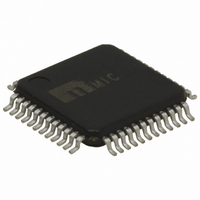MIC2590B-5BTQ Micrel Inc, MIC2590B-5BTQ Datasheet - Page 18

MIC2590B-5BTQ
Manufacturer Part Number
MIC2590B-5BTQ
Description
IC PCI HOT PLUG CTLR DUAL 48TQFP
Manufacturer
Micrel Inc
Type
Hot-Swap Controllerr
Datasheet
1.MIC2590B-2YTQ.pdf
(23 pages)
Specifications of MIC2590B-5BTQ
Applications
PCI, PCI-X
Internal Switch(s)
No
Voltage - Supply
3.3V, 5V, ±12V
Operating Temperature
0°C ~ 70°C
Mounting Type
Surface Mount
Package / Case
48-TQFP
Lead Free Status / RoHS Status
Contains lead / RoHS non-compliant
Available stocks
Company
Part Number
Manufacturer
Quantity
Price
Application Information
Current Sensing
For the three power supplies switched with internal
MOSFETs (+12V, –12V, and V
provides all necessary current sensing functions to protect
the IC, the load, and the power supply. For the remaining
four supplies which the part is designed to control, the
high currents at which these supplies typically operate
makes sensing the current inside the MIC2590B
impractical. Therefore, each of these supplies (3VA, 5VA,
3VB, and 5VB) requires an external current sensing
resistor. The V
(e.g., 5V
slot’s current sense amplifier, and the corresponding
SENSE input (in this case, 5V
negative terminal of the current sense amplifier.
Sense Resistor Selection
The MIC2590B uses low-value sense resistors to
measure the current flowing through the MOSFET
switches to the loads. These sense resistors are
nominally valued at 50mΩ/I
worst-case tolerances for both the sense resistor, (allow
±3% over time and temperature for a resistor with ±1%
initial tolerance) and still supply the maximum required
steady-state load current, a slightly more detailed
calculation must be used.
The current limit threshold voltage (the “trip point”) for the
MIC2590B may be as low as 35mV, which would equate
to a sense resistor value of 35mΩ/I
numbers through for the case where the value of the
sense resistor is 3% high, this yields:
Once the value of R
manner, it is good practice to check the maximum
I
tolerance build-up in the opposite direction. Here, the
worst-case maximum is found using a 65mV trip voltage
and a sense resistor which is 3% low in value. The
resulting current is:
As an example, if an output must carry a continuous 4.4A
without nuisance trips occurring, R
should be 34mΩ/4.4A = 7.73mΩ. The nearest standard
value is 7.5mΩ, so a 7.5mΩ ±1% resistor would be a
good choice. At the other set of tolerance extremes,
I
67mV/7.5mΩ = 8.93A. Knowing this final datum, we can
determine the necessary wattage of the sense resistor,
using P = I
(0.97)(R
LOAD(CONT)
LOAD(CONT, MAX)
Micrel, Inc.
September 2008
I
LOAD(CONT,
SENSE(NOM)
R
INA
SENSE
which the circuit may let through in the case of
) is connected to the positive terminal of the
2
R. Here I will be I
MAX)
for the output in question is then simply
IN
=
). These numbers yield the following:
connection to the IC from each supply
=
(
1.03
(
0.97
SENSE
)
35mΩ
(
I
)
LOAD(CONT)
(
R
65mΩ
SENSE(NOM)
LOAD(CONT)
LOAD(CONT, MAX)
has been chosen in this
SENSEA
LOAD(CONT)
AUX
)
SENSE
) is connected to the
=
. To accommodate
), the MIC2590B
)
I
LOAD(CONT)
=
34mΩ
R
for that output
, and R will be
. Carrying the
SENSE(NOM)
67mΩ
18
A 1.0W sense resistor would work well in this application.
Kelvin Sensing
Because of the low values of the sense resistors, special
care must be used to accurately measure the voltage
drop across them. Specifically, the voltage across each
R
means of making sure that any voltage drops in the power
traces connecting to the resistors are not picked up in
addition to the voltages across the sense resistors
themselves. If accuracy must be paid for, it’s worth
keeping.
Figure 9 illustrates how Kelvin sensing is performed. As
can be seen, all the high current in the circuit (let us say,
from +5V
+5VA output MOSFET) flows directly through the power
PCB traces and R
R
through the power traces will not introduce any
extraneous IR drops.
MOSFET Selection
Selecting the proper MOSFET for use as current pass
and switching element for each of the 3V and 5V slots of
the MIC2590B involves four straight forward tasks:
MOSFET Voltage Requirements
The first voltage requirement for each MOSFET is easily
stated: the drain-source breakdown voltage of the
MOSFET must be greater than V
question. For instance, the 5V input may reasonably be
expected to see high-frequency transients as high as
5.5V. Therefore, the drain-source breakdown voltage of
the MOSFET must be at least 6V.
Power Trace
From V
SENSE
SENSE
1. Choice of a MOSFET which meets the minimum
2. Determination of maximum permissible on-state
3. Selection of a device to handle the maximum
4. Verification of the selected part’s ability to
Figure 9. Kelvin Sensing Connections for R
CC
is sampled in such a way that the high currents
must employ Kelvin sensing. This is simply a
P
voltage requirements.
resistance [R
continuous current (steady-state thermal issues).
withstand
issues).
INA
to MIC2590B V
MAX
through R
Signal Trace
= (8.93A)
SENSE
current
DS(ON)
CC
2
SENSE
. The voltage drop resulting across
(7.28mΩ) = 0.581W
R
].
SENSE
and then to the drain of the
peaks
Signal Trace
to MIC2590B V
IN(MAX)
(transient
To MOSFET Drain
M9999-091808
for the slot in
MIC2590B
SENSE
Power Trace
SENSE
thermal













